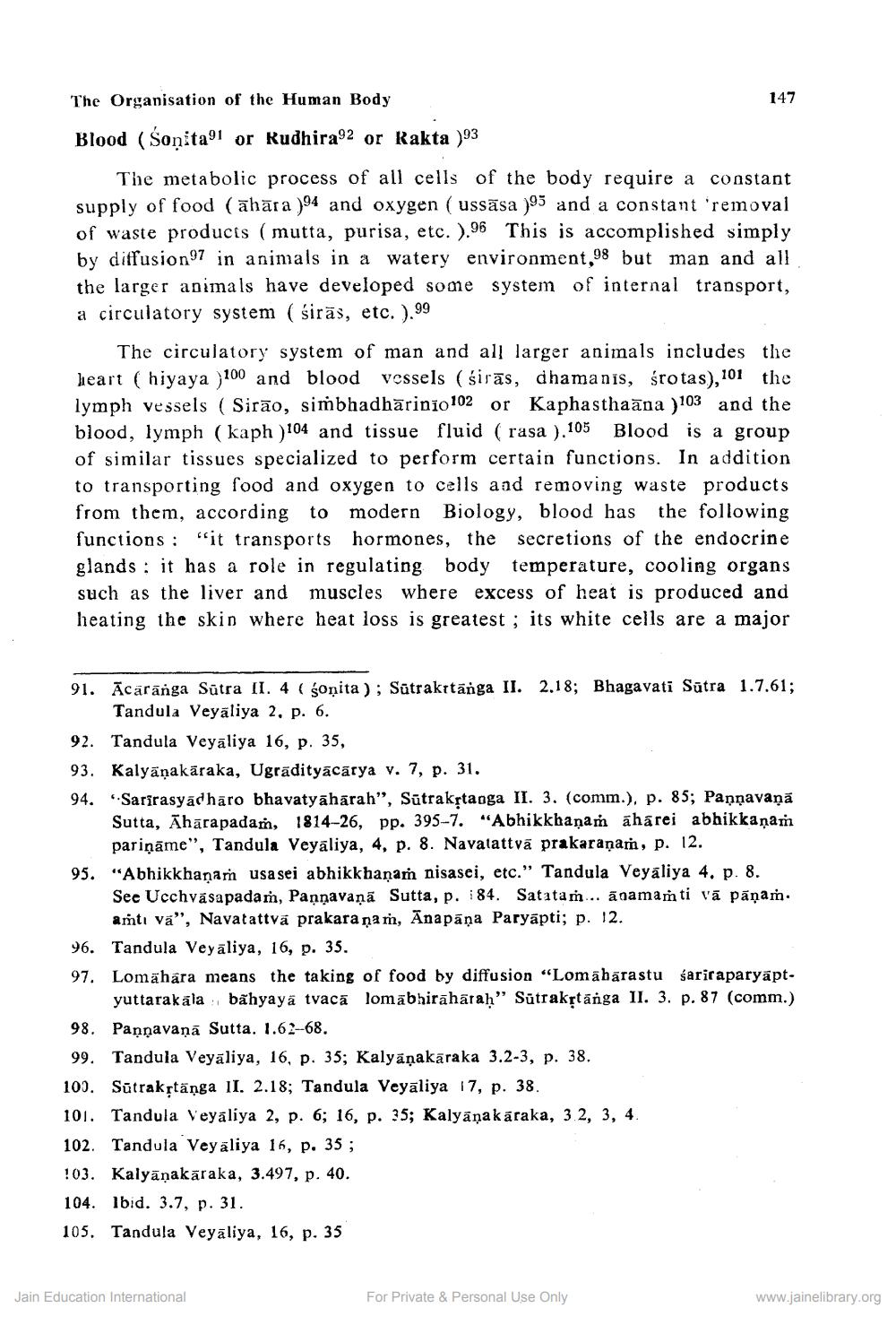________________
The Organisation of the Human Body
147
Blood (Sonita91 or Rudhira92 or Rakta )93
The metabolic process of all cells of the body require a constant supply of food (āhāra )94 and oxygen ( ussāsa )95 and a constant 'removal of waste products (mutta, purisa, etc. ).96 This is accomplished simply by diffusion97 in animals in a watery environment,98 but man and all the larger animals have developed some system of internal transport, a circulatory system ( sirās, etc. ).99
The circulatory system of man and all larger animals includes the heart (hiyaya 100 and blood vessels (širās, dhamanis, śrotas), 101 the lymph vessels (Sirāo, simbhadhārinio102 or Kaphasthaāna )103 and the blood, lymph (kaph )104 and tissue fluid ( rasa ).105 Blood is a group
similar tissues specialized to perform certain functions. In addition to transporting food and oxygen to cells and removing waste products from them, according to modern Biology, blood has the following functions : "it transports hormones, the secretions of the endocrine glands : it has a role in regulating body temperature, cooling organs such as the liver and muscles where excess of heat is produced and heating the skin where heat loss is greatest; its white cells are a major
91. Ācārānga Sūtra II. 4 (Sonita ); Sutrakitanga II. 2.18; Bhagavati Sūtra 1.7.61;
Tandula Veyaliya 2, p. 6. 92. Tandula Veyaliya 16, p. 35, 93. Kalyāṇakāraka, Ugrādityācārya v. 7, p. 31. 94. "Sarirasyadharo bhavatyaharah”, Sūtrakrtaoga II. 3. (comm.), p. 85; Paņņavaņā
Sutta, Ahārapadam, 1814-26, pp. 395-7. "Abhikkhaņań aharei abhikkanam
pariņāme", Tandula Veyaliya, 4, p. 8. Navatattvā prakaraṇam, p. 12. 95. "Abhikkhanar usa sei abhikkhanam nisasei, etc.” Tandula Veyaliya 4. p. 8.
See Ucchvasa padam, Pannavaņā Sutta, p. 184. Satatam... agamam ti vā pāņam.
artı va", Navatattvá prakara nam, Anapāņa Paryapti; p. 12. 96. Tandula Veyaliya, 16, p. 35. 97. Lomahára means the taking of food by diffusion "Lomahārastu sariraparyapt
yuttarakāla bãhyayā tvacā lomābhirāhāraḥ" Sūtrakstānga II. 3. p. 87 (comm.) 98. Paņņavaņā Sutta. 1.62-68. 99. Tandula Veyāliya, 16, p. 35; Kalyāṇakāraka 3.2-3, p. 38. 100. Sūtrakstānga II. 2.18; Tandula Veyaliya 17, p. 38. 101. Tandula Veyaliya 2, p. 6; 16, p. 35; Kalyāṇakāraka, 3.2, 3, 4. 102. Tandula Veyaliya 15, p. 35; :03. Kalyānakāraka, 3.497, p. 40. 104. Ibid. 3.7, p. 31. 105. Tandula Veyāliya, 16, p. 35
Jain Education International
For Private & Personal Use Only
www.jainelibrary.org




